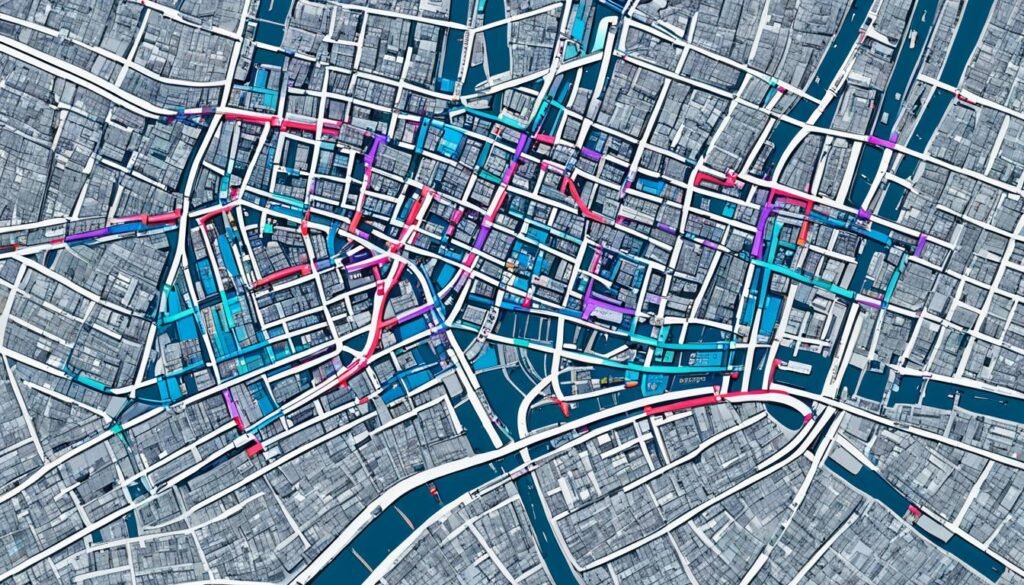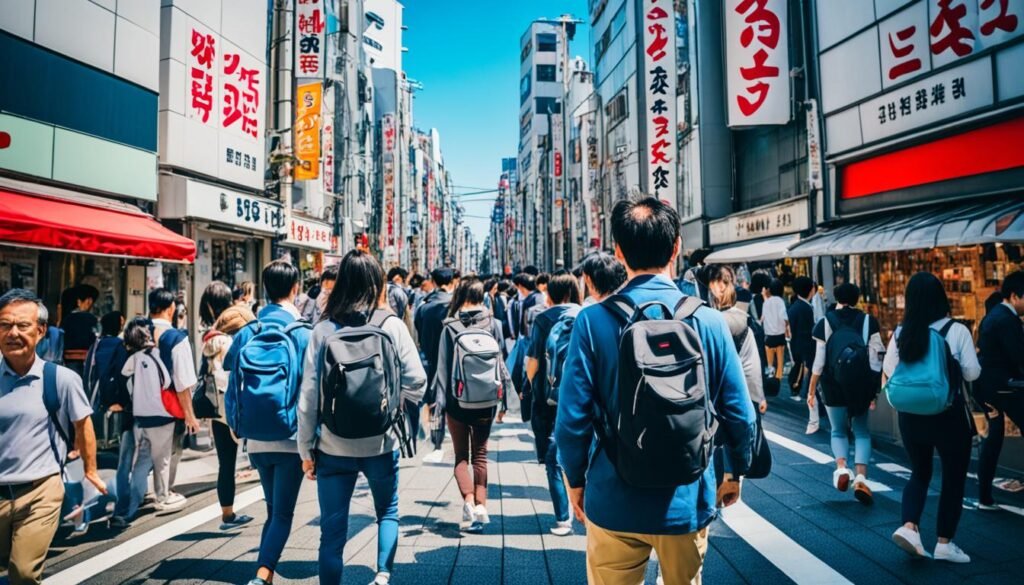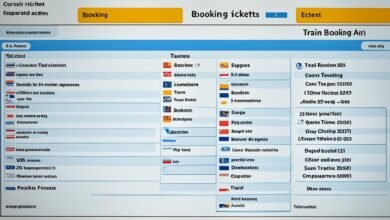Table of Contents
Getting around Tokyo’s busy streets might seem tough at first. Yet, it boasts one of the best public transport systems. You have many ways to move around this lively city, ranging from a vast metro to easy-to-find taxis and ride-sharing options. So, what’s the truly optimal way to explore Tokyo? Let’s look into the best options for your travel style and budget.
Tokyo, despite being massive, is well-connected through an extensive train, subway, and bus network. People often choose subways and trains as the best way to get around Tokyo. To pay, a Suica or Pasmo card is recommended. You can buy these cards online and pick them up at the airport. This gets you moving as soon as you land.
Taxis are convenient but can get costly. They are better for shorter trips or getting around late at night. Buses, on the other hand, are everywhere. Yet, they might be a bit confusing for newcomers due to their complex routes. So, for those visiting Tokyo for the first time, buses could be a bit tricky to use.
Understanding Tokyo’s Extensive Transportation Network
Tokyo has many train, subway, and bus lines run by different companies. The train lines by JR East and the subways are best for getting around central Tokyo. The JR Yamanote Line is Tokyo’s key train line, circling various city centers.
Tokyo’s Major Train and Subway Lines
In Tokyo, 13 subway lines help you move around. They’re managed by two companies, Tokyo Metro and Toei Subway. These lines are mainly inside the Yamanote circle, Ginza, and the area east of the loop line. They provide a fast way to explore central Tokyo.
Private Railway Companies Serving Tokyo
Many private railway companies also serve Tokyo’s outer areas. They include Tokyu, Tobu, Seibu, Keio, Odakyu, Keisei, Keikyu, and Tsukuba Express. Their lines boost travel options in greater Tokyo.
The Efficient Tokyo Subway System
Tokyo’s subway has two parts: Toei runs four lines, and Tokyo Metro runs nine. They cover central Tokyo well, especially inside the Yamanote circle and around Ginza. These areas lie east of the loop line. At their end stations, some Tokyo subway lines connect to trains of other companies. For instance, the Chiyoda Subway Line is linked to the Odakyu Line at Yoyogi-Uehara. And the Fukutoshin Subway Line connects to the Tokyu Toyoko Line at Shibuya.
The Tokyo Metro and Toei Subway work together to give a broad subway lines in Tokyo network. This system ensures you can easily move through the city’s core areas. It’s all part of what makes Tokyo’s public transit so great.
Navigating the JR Yamanote Line
The JR Yamanote Line is one of Tokyo’s most famous train lines. It’s like a big loop around the heart of the city. This makes it a key way to move between Tokyo’s big urban spots, fitting perfectly with the Greater Tokyo’s rich network.
Stations on the Yamanote Loop Line
The JR Yamanote Line takes you through some of Tokyo’s major lively areas. You’ll pass Tokyo, Ueno, Ikebukuro, Shinjuku, Shibuya, and Shinagawa. These stations are not only vibrant but also crucial for changing to other JR train lines and the subway.
Connecting to Other JR Lines
Aside from the JR Yamanote Line, it connects to many more Tokyo train stations and JR train lines. For example, the Keihin-Tohoku Line, Chuo/Sobu Line, and the Rapid Chuo Line. This network helps you easily visit different parts of Tokyo using the JR train network.
If you own a Japan Rail (JR) Pass, you can use it on the JR Yamanote Line for city adventures. But, for exploring city sights only, a Suica or Pasmo card might be better. Save your JR Pass for trips outside Tokyo later.
What’s the best way to get around Tokyo?
Prepaid IC Cards: Suica and Pasmo
Suica or Pasmo are the best to pay for trains and subways in Tokyo. You can even use them at stores. Look for Suica at JR stations. For Pasmo, check out non-JR stations.
Day Passes and Tickets Options
Many day passes are sold for getting around Tokyo. They include the Tokyo Free Kippu and Tokyo Subway Ticket. Also, the Toei and Tokyo Metro One-Day Economy Pass, Tokyo Metro 24-Hour Ticket, Toei One-Day Pass, and Tokunai Pass exist. But, most day passes are not the best value. They don’t cover all of Tokyo‘s lines. So, using single tickets or prepaid cards is usually cheaper.
Getting to and from Tokyo’s Airports
Tokyo has two main airports, Narita and Haneda. Narita Airport sees more international flights but Haneda is closer to the city. Visitors need to know how to travel between these airports and Tokyo.
From Narita Airport to Tokyo
The Skyliner train is perfect for getting from Narita to central Tokyo. It’s fast and connects directly to spots like Nippori and Ueno. This service makes arriving in Tokyo smooth and easy.
From Haneda Airport to Tokyo
From Haneda, the Tokyo Monorail provides a quick trip into Tokyo. It goes to Hamamatsucho Station, which links up with the city’s transport. Use a Suica or Pasmo IC card for a seamless journey.
Both airports connect well to Tokyo’s transport, making travel around the city simple. The Skyliner, Monorail, and more are available, ensuring you have an easy time exploring Tokyo.
Tokyo’s Comprehensive Bus Network
Tokyo’s buses cover a lot of ground and are well-managed, but for tourists, other options might be better. They are run by the Tokyo Metropolitan Bureau of Transportation (Toei) and private companies. Despite offering widespread service, Tokyo bus routes might not be the simplest for short-stay visitors. The complexity and possible language issues can make them challenging.
If you choose to experience getting around Tokyo by bus, you’ll discover its merits. Buses are a budget-friendly way to reach places less served by trains or subways. They let you experience the city in a different light, highlighting areas not typically seen while using other modes of transportation.

Preparing to use the Tokyo bus routes is advisable. Get to know the system and plan your journey. Because much information is in Japanese, bring a map or have a translation app ready. Some buses offer little English guidance, so being ready to seek help is wise.
In conclusion, while not the most straightforward for tourists, Tokyo’s buses offer unique travel experiences. They can be a useful part of your travel toolkit. Whether you opt for the subway, trains, or getting around Tokyo by bus, Tokyo’s all-encompassing transport network supports effortless exploration of the lively city.
Taxis and Ride-Sharing in Tokyo
Tokyo’s taxis are great for moving around, especially when it’s not busy. They are perfect if you need to reach a spot far from a train or subway. Yet, they can be pricey, not ideal for saving money if you use them a lot. Use taxis for quick, short rides or urgent trips to a certain place. They’re handy when other transport options are limited, like late at night or in quieter areas.
Ride-sharing services such as Uber are in Tokyo too. Despite this, taxis are often preferred for traveling around Tokyo by taxi. Tokyo’s taxi drivers are known for being professional and dependable. They ensure you get to where you’re going fast and safe, even without speaking Japanese.
Walking and Biking in Tokyo
Even though Tokyo has a top-notch transit system, exploring the city on foot or by bike is also rewarding. The best walking areas in Tokyo include Ginza, Asakusa, Ueno, and the Imperial Palace. These places let you see the city’s beauty up close while moving at a relaxed pace.
In Tokyo, there are more opportunities for biking with each passing year. You’ll find biking trails and rental options in places like Odaiba, the Sumida River, and the Tama River. Biking lets you travel farther and see Tokyo from another angle. But, it’s important to be careful on the busy roads and tight streets.
Best Walking Areas in Tokyo
Walking through lively Ginza, exploring the shops in Asakusa, or savoring the peace of the Imperial Palace grounds are great experiences. These places help visitors dive into Tokyo’s culture and architecture at a relaxed speed. It’s a peaceful way to enjoy the city.
Tokyo’s Biking Trails and Rentals
For a different experience, biking in Tokyo is fun and practical. There are marked paths by the Sumida River and in Odaiba for beautiful rides. Plus, renting a bike is easy. Even with Tokyo’s busy roads, cycling lets you see Tokyo freely and uniquely. Just be sure to watch out for traffic.

Using the Japan Rail Pass in Tokyo
The Japan Rail (JR) Pass is perfect for folks who want to see a lot of Japan. It lets you ride JR trains, including the cool shinkansen. But, if you’re mostly staying in Tokyo, it might not be the cheapest option.
For sightseeing in Tokyo, prepaid cards or single tickets are better. The JR Pass is great if you’ll be exploring many places beyond Tokyo.
Think about your travel plans when considering the Japan Rail Pass. It’s a smart buy for a big, wide Japan journey. Yet, for Tokyo itself, other ways could be more convenient and money-smart.
Tips for First-Time Visitors to Tokyo
First-time visitors to Tokyo should get to know the city’s transportation network. Learning to use the various trains, subways, and buses is key. Consider getting a prepaid Suica or Pasmo card for easy and flexible travel around the city.
Planning a sightseeing route wisely can save you time and money. It helps avoid costly taxi rides. Remember, if you’re unsure of the way, do ask for help. The Japanese are known for being helpful toward tourists.
With some planning, anyone can enjoy exploring Tokyo. The city is a unique and exciting place, full of adventures for first-time visitors.




